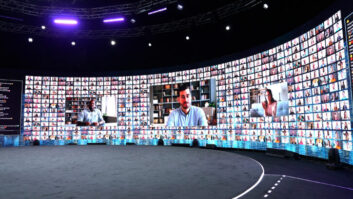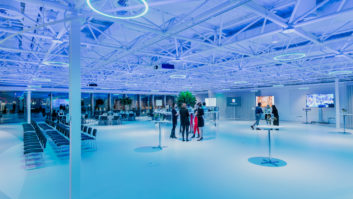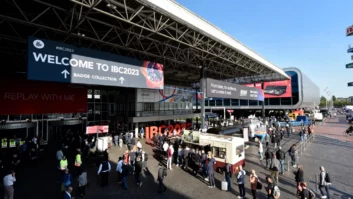
Online video will account for 80% of worldwide internet traffic by 2019, according to Cisco – and businesses and organisations are making an increasingly substantial contribution to this figure. Ian McMurray reports on how the convergence of the broadcast and AV worlds is affecting this trend.
If you were at ISE earlier this year, the chances are you heard a good deal of discussion about the impact of 4K and HDR. You probably heard people discussing the challenges of accommodating multiple portable screens. And you’d almost definitely have listened to conversations about the challenges – and opportunities – presented by IP.
Conversely, if you were at IBC last autumn, you’d have heard people discussing what 4K and HDR might mean. You would likely have heard visitors wondering how to get content to multiple portable screens. And you’d certainly have overheard conversations about the opportunities – and challenges – presented by IP.
Yes: the worlds of AV and broadcast are becoming increasingly difficult to tell apart – and nowhere are their growing similarities better illustrated than in the distribution of audio and video within corporate offices, leisure facilities, sports arenas and so on. Of all those similarities, the transition towards IP – the so-called ‘IT-ification’ of both industries – is perhaps the most significant one.
“AV over IP is quickly replacing conventional AV technology, and this really affects all markets,” says Erik Indresovde, director of AV products at Black Box. “We see a very quick adoption in the hospitality industry, where hotels, bars and casinos are trying to get dynamic messaging and TV signals out to a large audience, and corporate AV and education are also growth areas for IP-based AV. Furthermore, it’s largely driven by integrators with a desire to provide their end customers with the most innovative and cost-effective technology.”
“Without doubt, the broadcast video/audio market is now very focused on the capabilities and advantages being offered by the IT industry,” notes Stephen Brownsill, audio product manager, TSL Products. “Many in the broadcast industry are now looking to adopt IT technologies not only to distribute their content, but to create it also.”
Viable fabric
“Delivering video from a playout origin to the destination can be designed a number of ways,” explains Will Waters, director of product marketing for NewTek. “In very general terms, there are two ways to deliver video: RF (radio frequency) and IP (internet protocol). RF has served us well, but in recent years, IP networks have gained the speed and capacity to become a viable distribution fabric. NewTek is developing IP-based video products to help integrators bring solutions to end-users.”
“End-to-end IP video systems are in particularly high demand due to their capacity to receive, convert and distribute high-quality video content to any device connected over any network, enabling an organisation to create its own personalised TV and video service,” adds Colin Farquhar, CEO at Exterity. “In addition, IPTV systems are scalable and easily integrate with the broader AV and IT systems, including digital signage, CCTV or network monitoring platforms, and enable system administrators to access and control all components at once.” Exterity, as Farquhar notes, has a comprehensive range of products designed to enable organisations to harness their IPTV networks, from capture through encoding, transcoding and receiving to monitoring and control.
According to James Keen, marketing manager, Tripleplay, video over IP need not be as complex as it may sound. “Essentially, you need very little equipment,” he claims. “Modern video-over-IP solutions, such as ours, allow IPTV and VOD streams to be delivered across an IP network, securely to SoC-equipped screens and smart TVs directly from the headend server with nothing in between. In this instance, all encoding and transcoding is handled by the headend server, with the end device handling the decoding. This method simplifies implementation, reduces costs and makes for ease of upgrade.”
New vocabulary
As the worlds of AV and broadcast converge, it’s incumbent on AV integrators to become proficient in a new vocabulary. The broadcast world, for instance, routinely talks about a “headend” – the point at which content is received for distribution. There are others.
“Simple differences exist in language and jargon between the two worlds,” smiles Craig Heffernan, technical sales manager at Blackmagic Design. “For example, broadcasters refer to workflows, while AV integrators refer to solutions or designs. But, if you understand the fundamentals of video signals, the use of broadcast products in a solution is only a matter of familiarising yourself with their features and operational use.
“The integration and use of broadcast video/audio products does require some understanding of differing features, signal carriers or connections,” he goes on, “but it shouldn’t be a reason to avoid using these technologies. ‘What is SDI?’ for example, is a common question. It’s simply a digital video carrier with embedded audio – the backbone of broadcast infrastructure, and incredibly reliable.”
It was certainly interesting, at IBC last year, to hear a recurring refrain: “In the future, everyone will be a broadcaster” – a reference not only to the growing demand for video distribution systems, but also to the increasing commoditisation of the equipment needed to be a broadcaster. Bridge Technologies, for example, debuted NOMAD – a portable probe designed to troubleshoot and optimise IP networks, but aimed squarely at those who are just becoming involved with them.
“Many organisations in corporate, finance, education, hospitality, healthcare, entertainment and sports consider themselves micro-broadcasters,” says Farquhar. “The presence of broadcast-grade technology across these ranging industries has transitioned from a nice add-on to a necessary prerequisite to effectively and seamlessly communicate with a wide range of key audiences. Schools rely on broadcast-grade technology to educate and communicate with their students; hospitals use it to provide bedside entertainment options for patients; stadiums use it to feed fans with continuous live match footage and other engaging digital content throughout the venue – and the list goes on.”
www.blackbox.com
www.blackmagicdesign.com
www.exterity.com
www.newtek.com
www.tripleplay.tv
www.tslproducts.com







